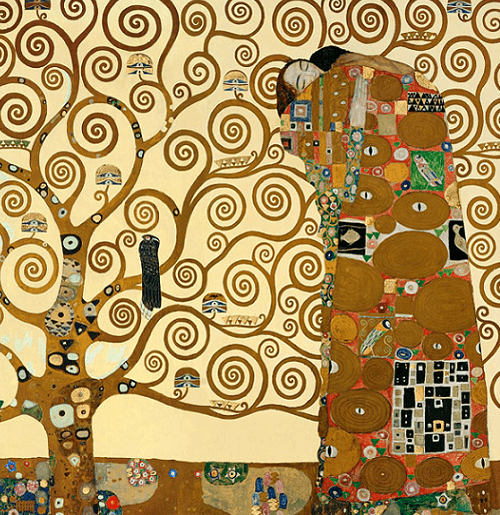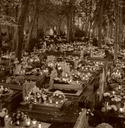It is now a common feature of American life to see life-style guides, manuals and gurus offering their path to the good life. We have advice from de-cluttering, tidying up, and folding (no, rolling!) clothes (Marie Kondo), to keeping your sink in sparkling clean condition 24/7 (the "Fly Lady”), and everything in-between. There must be a need, given the market for such things. Yet one can’t help but think that this market fills the void of a wisdom that was once handed down through the generations in the families and communities to which one once belonged.
These new manuals are much like the cook-books, diet books (low fat, high fat), and foodie life-style books (free-cycling, vegetarian, vegan, no-cook, paleo, gluten free) that fill our bookshelves (and now, our toolbars) that take the place of the mothers who once taught their daughters how to cook, how to “source” ingredients, as well as how much, and when, to eat. Vacuums have to be filled, of course, but substitutes are never the same as the things they replace. One might, for example, be able to churn out any number of recipes without actually knowing how to cook, without having the art of cooking. As for the proliferation of diets and foodie life-styles, it is the art of eating that seems to have gone missing. In our pull-ourselves-up-by-the-bootstraps tradition-less manner of eating, the loss is detected in the absence (even banishment) of at least one of the essential ingredients, and one-sided exaggeration of others. What is missing above all, though, is the most essential ingredient, which is not an ingredient at all: it is the whole human context in which eating makes sense in the first place: the common table − where family and friends eat together. Allergies and intolerances aside, the new food fetishism has practically excluded communion at the table, since few “can” – or will − eat what they are served.
With the new life-style books, manuals, and movements, one perceives something similar. Understandably, without having learned through tradition the art of living a good life, we turn to these. Each of them can offer good ideas and advice: hide the electrical wires, make sure your bed faces the door, but doesn’t line up with it (Feng Shui), throw away seven things per day, downsize your wardrobe to the essential, if not the high-end wardrobe “capsule.” But there is a tendency for each of these to become its own mania, to the exclusion of other important dimensions of an orderly life. How, for example, is one to find time for that daily workout, if one is rolling (not folding!) all day? What is more, the underlying reason why an orderly life is to be pursued and lived in the first place is often entirely missing. It is hard not to notice the almost complete absence of children, for example, in the pages of the perfectly ordered (painted, stenciled, and furnished) homes that fill the pages of Martha Stewart’s Living. And here is where we come to the Minimalist movement.
At the moment, the minimalist movement is all the rage with four million followers. It is led chiefly by Joshua Fields Millburn and Ryan Nicodemus, appropriately named “the Minimalists.” One can follow them by reading their book Minimalism [1] (a mere 121 pages) and/or by accessing their beautiful, black and white website, also of minimal proportions. Here is the back story to what now has become their joint enterprise. Joshua and Ryan had been classmates since fifth grade, and then reconnected in their late 20s at the peak of what each had envisioned as the successful life, defined as it was by the famous “six figure income” and all the “manufactured contentment” that went with it. Finding themselves both discontented − with all the stuff, the rat race, the stress, the happiness deferred until retirement − and feeling their mortality for the first time (after the death of one of their mothers), they began to ask themselves what was genuinely worth pursuing. What would make them happy? What would give them a more meaningful life? In time they came to identify “meaning” with one of the five basic essentials: health, relationships, pursuit of passions, growth, and contribution to others. Here is where “minimalism” comes in. It is a way to privilege these five “essentials.”
Minimalism is a tool we use to live a meaningful life. There are no rules. Rather, minimalism is simply about stripping away the unnecessary things in your life so you can focus on what’s important. Ultimately, minimalism is the thing that gets us past the things so we can focus on life’s most important things – which actually aren’t things at all. [2]
So far so good. There is much good advice about getting rid of excessive stuff, and most especially of habits that take away from time well-spent: surfing and shopping on the internet, excessive time spent in the daily commute to and from work, and so on. In many ways the minimalist movement is reminiscent of the medieval friars who disencumbered themselves of their possessions – even their cloaks – in order to strip down to the bare essentials. Who is not for getting rid of all that excess to focus on the essentials, to focus on what is important? But is minimalism’s “essential” essential enough? Is its bare minimum bare enough?
Here is where the hipster version of dis-encumbrance parts ways with that of St. Francis. When St. Francis took leave of his father and his father’s home, he did it to bind himself further to a new brotherhood, even to the places they would eventually build, for a life lived together in obedience. With minimalism, on the contrary, the “essential” is always under one’s control, in view of open-ended flexibility. Examples of minimalists who own nothing but the back pack on their backs and who are in a constant state of travel, checking off items on the bucket list, or of those who live in “micro-houses” − tethered to the earth by nothing more than an electrical cord − come to mind. Essentially, minimalism’s “essential” isn’t bound to anything. Indeed the “inessential” things are “anchors,” which “make us feel stuck and keep us from growing,”[3] and take away the “focus on what’s important.” And the list isn’t limited to over-stuffed closets and attics, but to things like work− if it’s not a “passion”− and daily life no less.[4] But this “anchors away” approach to stuff, and to houses, work and daily life, is only a symptom of a deeper unboundedness. Minimalism’s “essential” isn’t bound to anyone. Where, in fact, are all the mothers and fathers, sisters and brothers, husbands and wives, and children? Where do they fit in the “micro-house,” so to speak? In fairness, they can in fact be there. But they now belong to the hipster “relationships,” which are always under one’s deliberate control and subject to routine assessment, even re-negotiation when necessary. On their web-site the Minimalists say: “Allow nothing in your life that you cannot walk out on in 30 seconds flat. . . . Almost everything I bring into my life—material possessions, ideas, habits, and even relationships—I must be able to walk away from at a moment’s notice.”[5]
Again, to be fair, marriage does a little better than other “relationships.” You don’t leave it in “30 seconds flat.” You have to wait a little longer. Say the Minimalists: “we can ultimately walk away when these situations no longer add value to our lives.” (The Minimalists, by the way, are both divorced.)
Everything, then, depends on what you think the essential is, on what the bare minimum is. If we no longer belong to and are defined by the rhythm of the generations − to a particular past and a particular future, and to its places − then we have no good reason to hold onto our stuff. It would, in fact, be a virtue to get rid of it. If we do, on the other hand, the terms of our relationship to stuff changes altogether. In a wonderful article on the virtue of simplicity, written by a consummate hoarder, in a funny book entitled The Seven Deadly Virtues,[6] James Lileks writes about his grandmother’s hat-pin box:
I didn’t know it was from the 1893 Columbian Exposition until I took Brasso to its tarnished finish. Inside is a thin ribbon of gold, which was removed from the bridgework of my great-grandfather after his death. My daughter thinks this is TOTALLY DISGUSTING. But I put the box in her hand and say: You’re holding something from a man who fought for the Union. He lay on the battle-ground left for dead, but got up, healed, headed north, and split the sod. He is the reason we’re here. Everything can go in the cloud but that. Over this gold his breath passed, his words moved.[7]
Offering, then, the reason why we hold on to stuff, Lileks, continues:
Simplicity is a virtue, but it’s often misunderstood. People take it to mean that stuff doesn’t matter. We tell ourselves that it’s virtuous to divest, lest we become hoarders. The thing about hoarders, though, is that they think they’ll need their stuff someday. They have it backward. The stuff needs us to tell their stories. Just once. Before they pass along to the next set of hands. The things we save are nuggets in a sieve, and when our hand falls from the handle they tumble into the river again. But for a while you can handle the physical object and conjure its story.[8]
It is because, then, of something more essential at the heart of ourselves − and our happiness, or meaning − that the material dimensions of a more rooted minimalism might differ. Indeed that essential would require us to re-think the value of the current minimalism’s most banished ingredient: stuff. It would require us to give greater weight to beautiful, solid, quality stuff−things handed down, things for living now, and things to hand on−including the containers in which to put it all: linen closets, hope chests, china cabinets and attics. Enough for the members of the family and their guests. And in houses big enough to contain it all.
But there is something even more basic that doesn’t figure into minimalism’s “essential,” namely religion: boundedness of a vertical kind. That too is one of the many “anchors.” St. Francis, of course, dis-encumbered himself to be bound by that “Anchor.” But it was that same Anchor–being the God of Creation, Incarnation and Resurrection−that had him and so many brothers, sisters, monks, and nuns anchor themselves to each other, and to the beautiful, big, solid places, where they, among other things, dedicated themselves to the cultivation and production of so much good stuff! A bare minimum, yes. But a bound one, vertically and horizontally. And for that a more generous one.
[1] Joshua Fields Millburn and Ryan Nicodemus, Minimalism – Live a Meaningful Life (Missoula, Montana: Asymmetrical Press, 2016).
[2] Minimalism, 25.
[3] Minimalism, 17.
[4] Minimalism, 79.
[5] http://www.theminimalists.com/walk-away/
[6] The Seven Deadly Virtues, edited by Jonathan V. Last (West Conshohocken, PA: Templeton Press, 2014).
[7] The Seven Deadly Virtues, 119.
[8] The Seven Deadly Virtues, 120.



